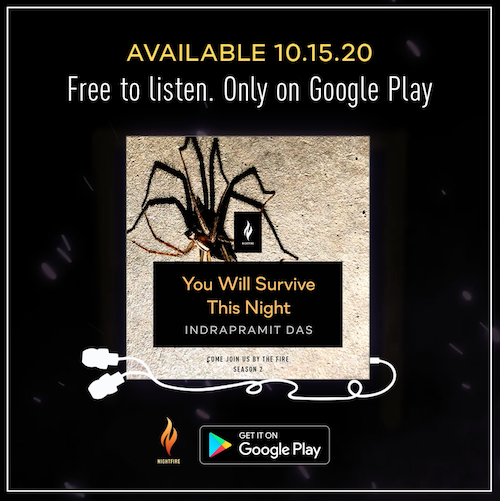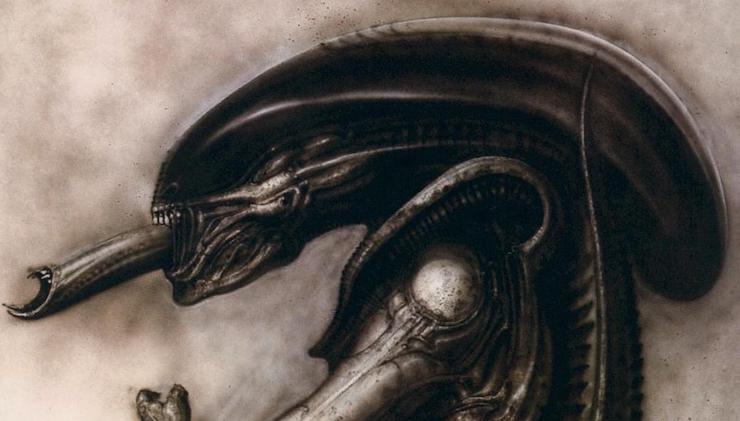Indrapramit Das on the Monstrousness of the Real
To celebrate the release of the second season of Come Join Us By The Fire, our audio horror anthology, we’ve asked authors with stories included in this year’s anthology to join us and write about horror. Below, Indrapramit Das, whose story “You Will Survive This Night” you can listen to here, writes about the horror intrinsic to all art.
Life is ceaseless horror. This isn’t something you find out until you’re somewhat of age, if you’re very lucky––lucky enough to have a family that cares for you, a roof over your head, and enough food and water to sustain your fragile body. But horror, the genre, sometimes feels like the most comforting thing in the world to the ones who love it––perhaps because in art, that horror so intrinsic to seeing the world through the prismatic brain of a sentient ape transmutes into creation. Perhaps that’s where our pleasure is to be found––in that uncanny balance between creation and destruction. What is horror, after all, but our hyper-awareness of entropy, manifesting as art?
Art has always been linked with horror, for me. It was the sentence scrawled at the edge of life’s map: here be monsters.
Before I read could read anything other than children’s books and abridged classics, I found it in the movies. At that age, movies were dreams to me. I hadn’t quite figured out the level of artifice involved, so our quaintly small-by-modern-standards TV set became a Schrödinger’s box beaming out unstable realities. In these realities, I saw my fears reflected back at me.
Even in the classic Disney movies we wore out on VHS, which I knew were drawn and painted by people and were meant for children, there was vaccine of fear (reversible in happy endings, but vivid). Snow White stalked through a living, writhing forest, Baloo the Bear slashed and left to die in the rain, his loved ones pressing against the bulk of his body in despair (I couldn’t bear it, but I watched enthralled every time). But when we watched the occasional live action film, the nightmare of art took on new dimensions. When Salieri’s father dies choking on a fishbone in Amadeus, that splinter of dead animal remained in me, and filled me with panic whenever I ate fish and felt their thorny bones prick my throat. Indeed, when Mozart dies in Amadeus, I was inconsolable, because I knew he’d been a real person, and the movie had made him seem even more real. To see him haunted by a phantom of his dead father (or so I thought, unable to parse the plot—it was Salieri) until he joins him, and then tossed unceremoniously in a pauper’s grave on our TV, while we sat in our home in the twentieth century listening to his stirring music over the credits, gave me one of my earliest existential crises.
Everyone dies, and everyone has died. Even parents. Even Mozart.
I guess this is all to say that horror isn’t just a genre to me; it’s a part of any and all art, just like what marketing calls ‘science fiction’ or ‘fantasy’ or ‘speculative fiction.’ Fantasy is the gift that language and opposable thumbs gave us: to tell the impossible into reality. Horror is the sharp edge of that impossibility. Both can infiltrate any and all ‘genres,’ including mimetic storytelling, because they’re a part of any human life—our myths, folklores, superstitions, religions, dreams, nightmares, mortality are pregnant with terror and magic. This tricksy shapeshifting is part of why I love them.
So it’s in that gelid border between artifice and reality, fear, and delight, that my love for horror bloomed. I was around six or seven, probably around the same time I first saw Amadeus with the family, when I began perusing a book that my parents owned. It may as well have been the Necronomicon. It was actually a book about the making of Ridley Scott’s iconic sci-fi horror film, Alien. In that book I found the art of Chris Foss, Moebius, and one H.R. Giger. I’d never seen the film, of course. I was too young to understand most of the words in the book. But I was transfixed by the gorgeous artwork and photos of life forms that didn’t exist, of a spaceship and a crew visiting a desolate world far beyond our own. A tale of a journey into the unknown, and finding death there: the story of life itself.
I remember thinking it was all real.

In particular: the famous still of John Hurt with the facehugger embracing his head like a gigantic, pallid spider, its tail a serpentine snare around his neck. The legs reminded me of the huge spiders I saw skittering up walls at my extended family’s old house. I saw the moisture glistening on that unreal, arachnid thing, a creature raised straight from humanity’s limbic terror at the venomous dangers of the unknown, its phallic ovipositor and suffocating, intimate mode of attack signaling fears I was too little to even comprehend. I saw its victim, skin flushed, hair soaked in sweat between its skeletal-finger legs. I saw what looked like surgeons gathered to try and cut it off him. I knew photos showed real life, and if they showed a monster wrapped around a man’s face, that monster must exist. None of it looked fake, after all. My response wasn’t traumatic; it was love, for this terrifying creature, this facehugger that laid an egg, which erupted from man’s chest to turn into a warped simulacrum of a human, head sleek and elongated to reflect our fears back at us like an obsidian mirror.
In my malleable young brain, the book was a document of a true reality, even though I had some understanding that it was about a movie. Perhaps I thought this unseen movie was a documentary, charting something that had actually happened. And in a sense, it had: people had written a nightmare, had built sets and costumes and models, and acted out that nightmare for a machine that preserved it for cultural memory. That was the alchemy of art. It made monsters real. It made monsters beautiful. That is the appeal of horror, of fear sliced from actuality and placed in the petri dish of the imagination.
My parents explained to me that the book described a movie, like so many I’d seen. They told stories of going to see Alien in a theatre before I was born, of people walking out in horror when that human chest so notoriously exploded to birth a new legend. I began to understand, and became obsessed with creating monsters, drawing them, imagining strange and impossible life cycles like Giger had. I understood that monsters were gods of a sort: imaginary, but no less real for that. Like gods, they were everywhere, there to be hated and worshipped, loved and loathed, for what they represented about humanity.
Art, and with it horror, has always been with me, gestating inside me until I myself found participating in its life cycle, and creating it. In the words of Ripley from Alien 3, “You’ve been in my life so long, I can’t remember anything else.” My first love for the genre itself in the written word came, perhaps unsurprisingly, from reading Stephen King, whose style I mimicked like a devout faithful in creative writing classes at school (it worked, my teachers were impressed). But I already loved the horrific in art, in everything from movies and TV to the books of Roald Dahl (whose novel The Witches birthed in me a deep and anxious fear of losing my parents to a car crash whenever they went out; aptly, it was in this limbo of fear that my brother and I often secretly watched 18+ movies on cable at night, enhancing the illicit allure of their bloodshed and nudity).
Of course, monsters do exist. In reality, they’re often boring—evil people with venal ambitions, who build and sustain evil systems to hoard power and wealth and kill people they consider less than human (monsters, again). Today, they’re visible everywhere, in the highest positions of authority in the world. The wealthiest and most powerful people in the world, getting richer as the world’s ecosystem collapses and systemic evils flourish under the ravenous ambit of their corporations and genocidal governments. What B-movies and pulp and genre fiction have called supervillains for many decades, but without the imaginative flourishes.
But in horror, in myth, in fiction: monsters are worthy of respect. Because they are humanity’s aspirations of what we think we look like, as devourers and creators of worlds. Gods and devils in the most ancient of mythologies were the first monsters, with their capricious cruelty, immense power, and terrible beauty. Sometimes, monsters embody both side of our evil: aggressor and victim, like Mary Shelley’s murderous ‘daemon’ in Frankenstein, cursed by a disdainful creator and cruel world to shattering loneliness. Monsters are the spawn of our love for ourselves, our own art, our creations, which must necessarily be imbued with our own evil and self-loathing. They are the gods of horror, and it is only inevitable that we love them. Even if you don’t love the genre, or the elements of art we call horror, you love monsters, just as you hate them. You know you do, because you are one. We all are. In horror, we can defeat evil and befriend it, meet Death in its numerous incarnations and live to tell the tale, slain and resurrected forever.
Indrapramit (Indra) Das is a writer and editor from Kolkata, India. He is a Shirley Jackson Award-winner for his short fiction, which has appeared in several publications including Clarkesworld Magazine, Asimov’s, Slate Magazine, Strange Horizons, and Tor.com, and has also been widely anthologized. He is an Octavia E. Butler Scholar and a grateful member of the class of Clarion West 2012. Indra’s debut novel The Devourers was the winner of the 2017 Lambda Literary Award for Best LGBQT SF/F/Horror. The novel was also placed on the 2017 Honor List for the Otherwise Award, and shortlisted for the Crawford Award, the Shakti Bhatt First Book Prize, and the Tata Live! Literature First Book Award.
Listen to Indrapramit’s story “You Will Survive This Night” on Google Play here, and listen the the entirety of the second season of Come Join Us By The Fire here.




2 thoughts on “Indrapramit Das on the Monstrousness of the Real”